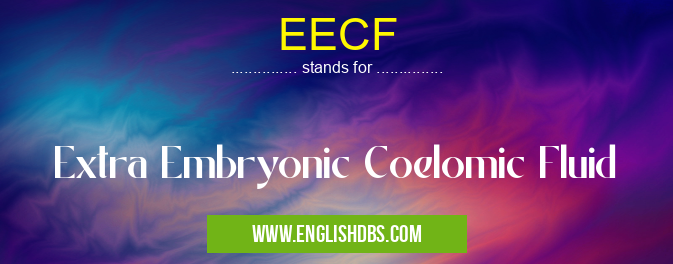What does EECF mean in UNCLASSIFIED
EECF stands for Extra Embryonic Coelomic Fluid. It is a specialized fluid-filled cavity that surrounds the developing embryo in many animals, including humans. The EECF provides a protective and nurturing environment for the embryo and plays a crucial role in its development.

EECF meaning in Unclassified in Miscellaneous
EECF mostly used in an acronym Unclassified in Category Miscellaneous that means Extra Embryonic Coelomic Fluid
Shorthand: EECF,
Full Form: Extra Embryonic Coelomic Fluid
For more information of "Extra Embryonic Coelomic Fluid", see the section below.
Function of EECF
The EECF serves several important functions during embryonic development:
- Protection: The EECF cushions and protects the embryo from mechanical shocks and external influences.
- Nutrient Supply: The EECF contains nutrients and oxygen essential for the growth and development of the embryo.
- Waste Removal: The EECF helps remove waste products from the embryo and transport them to the placenta for excretion.
- Regulation of pH and Temperature: The EECF helps regulate the pH and temperature of the embryonic environment, creating optimal conditions for development.
- Communication: The EECF facilitates communication between the embryo and the maternal tissues by transmitting chemical signals.
Composition of EECF
The EECF is composed of various substances, including:
- Water
- Proteins
- Carbohydrates
- Electrolytes
- Hormones
- Growth factors
The composition of the EECF changes dynamically throughout embryonic development to meet the changing needs of the embryo.
Essential Questions and Answers on Extra Embryonic Coelomic Fluid in "MISCELLANEOUS»UNFILED"
What is Extra Embryonic Coelomic Fluid (EECF)?
EECF is a fluid-filled cavity that surrounds the developing embryo and yolk sac. It provides a protective environment for the embryo and facilitates the exchange of nutrients and waste products between the embryo and its surroundings.
What is the composition of EECF?
EECF is composed of water, electrolytes, proteins, carbohydrates, and other organic molecules. It is similar in composition to blood plasma.
What is the role of EECF in early embryonic development?
EECF plays several crucial roles during early embryonic development, including:
- Protection: It cushions the embryo from mechanical stress and provides a physical barrier against infection.
- Nutrient exchange: EECF facilitates the diffusion of nutrients from the yolk sac to the embryo and the removal of waste products.
- Immunological defense: EECF contains proteins that help protect the embryo from immune attacks.
- Signaling: EECF contains signaling molecules that regulate embryonic development.
How is EECF formed?
EECF is formed through the process of extraembryonic coelomogenesis. This involves the formation of a cavity within the trophoblast, the outermost layer of the early embryo. The inner layer of the trophoblast lines the EECF cavity.
What happens to EECF as the embryo develops?
As the embryo develops, the EECF undergoes a gradual reduction in size. This occurs due to the formation of the amniotic and chorionic membranes, which enclose the embryo and yolk sac within separate cavities. The EECF is eventually reabsorbed into the embryo's circulatory system.
Final Words: The EECF is an essential component of the embryonic environment, providing a protective, supportive, and nutrient-rich environment for the developing embryo. Its functions are critical for the proper growth and development of the fetus. Understanding the role of EECF is important for research on embryonic development and reproductive health.
